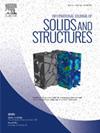Effective elastic moduli and failure mechanisms of a random assembly of thin walled glass microbubbles
IF 3.8
3区 工程技术
Q1 MECHANICS
International Journal of Solids and Structures
Pub Date : 2025-06-16
DOI:10.1016/j.ijsolstr.2025.113528
引用次数: 0
Abstract
In this work a methodology is presented to estimate the elastic properties and failure mechanisms of an assembly of random, brittle microbubbles. The approach is based on the mechanics of frictionless micro-contact between hollow spherical shells by employing relations from classical shell theory and verified by two dimensional axisymmetric Finite Elements. The estimated values are in agreement with available experimental values. Moreover, a granular type analytical homogenization model provides an isotropic elastic constitutive law to be used for the macroscopic deformation of an assembly of glass micro-bubbles when it is compressed by external loads. In addition, approximate estimates are also proposed for two important micro-failure mechanisms of such assemblies that relate either to the splitting or to the buckling of a brittle spherical shell, prior its complete crushing. The results are novel and are expected to enhance the application of glass microbubbles directly in acute thermal insulation problems such as liquid hydrogen storage.
薄壁玻璃微泡随机组合的有效弹性模量及破坏机制
在这项工作中,提出了一种方法来估计随机脆性微泡组合的弹性特性和破坏机制。该方法基于空心球壳间无摩擦微接触力学,采用经典壳理论的关系式,并用二维轴对称有限元进行了验证。估计值与现有的实验值一致。此外,颗粒型分析均质模型提供了一个各向同性的弹性本构律,用于玻璃微泡组合在受外载荷压缩时的宏观变形。此外,还提出了两种重要的微破坏机制的近似估计,这两种机制与脆性球壳在完全破碎之前的分裂或屈曲有关。这些结果是新颖的,有望加强玻璃微泡在诸如液氢储存等急性绝热问题中的直接应用。
本文章由计算机程序翻译,如有差异,请以英文原文为准。
求助全文
约1分钟内获得全文
求助全文
来源期刊
CiteScore
6.70
自引率
8.30%
发文量
405
审稿时长
70 days
期刊介绍:
The International Journal of Solids and Structures has as its objective the publication and dissemination of original research in Mechanics of Solids and Structures as a field of Applied Science and Engineering. It fosters thus the exchange of ideas among workers in different parts of the world and also among workers who emphasize different aspects of the foundations and applications of the field.
Standing as it does at the cross-roads of Materials Science, Life Sciences, Mathematics, Physics and Engineering Design, the Mechanics of Solids and Structures is experiencing considerable growth as a result of recent technological advances. The Journal, by providing an international medium of communication, is encouraging this growth and is encompassing all aspects of the field from the more classical problems of structural analysis to mechanics of solids continually interacting with other media and including fracture, flow, wave propagation, heat transfer, thermal effects in solids, optimum design methods, model analysis, structural topology and numerical techniques. Interest extends to both inorganic and organic solids and structures.

 求助内容:
求助内容: 应助结果提醒方式:
应助结果提醒方式:


